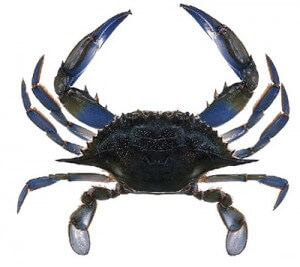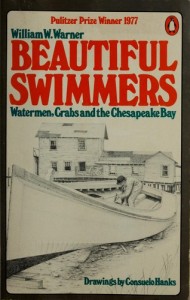It was the favorite book of the poet’s father, Beautiful Swimmers, a collection of tales about the Chesapeake that won the Pulitzer Prize for non-fiction in 1977.
That’s how good Beautiful Swimmers is.
“The subject matter of Dad’s paintings always remained the same — time-worn boats and buildings and farms along with landscapes of the Eastern Shore,” said Jenny Keith, a Baltimore poet who keeps some of her father’s work on the walls of her writing room.
Betts began taking his family to Ocean City in the early 1960s – the Satellite Café at 24th and Baltimore was a favorite – and by the time Swimmers was released by Little Brown in 1976 had taken to solitary afternoons wandering Chincoteague with a sketch pad.
“He was very moved by that book and the drawings in it by Consuelo Hanks,” said Keith. “He was fascinated by the people who made their living along the Bay, and his paintings, although they never included people in them, told stories about the difficulties of living at the mercy of nature.”
Beautiful Swimmers poetically details crabbers beholden to nature – and man-made pollutants – along the Bay and its 150 creeks and rivers that drain into it.
“Good writing merging science into the reader’s normal world,” said Ann Finkbeiner, who taught science writing at Johns Hopkins University.
The title is taken from the Latin name for the blue crab species – Callinectes sapidus – which also includes the most important part of the definition: beautiful SAVORY swimmers.
The book was the first for Warner [1920-to-2008], a longtime Washington resident who turned his labors to writing as he approached his 60th birthday, having retired from the U.S. Foreign Service.
It was praised equally for the lyricism of its prose and the accuracy of the science and the kind of book Marylanders mail to relatives who have moved away to remind them of the charms of the Land of Pleasant Living.
“My father gave me this book when it was new and I was in college and just starting to think that maybe I could write for a living,” said Heather Dewar, a former environmental writer for the Baltimore Sun.
“My dad taught me to love salt water, sea creatures, fishermen, their traditions and their boats. William Warner taught me to write about them. I’ll never match his skill but it’s wonderful to try.”
“Willie was the guy who encouraged me to write books,” said Tom Horton, author of An Island Out of Time: A Memoir of Smith Island, published in 1996. “He was a very important person in my life … a very sweet man.”
Very simply, said noted Maryland espionage author Dan Fesperman, Beautiful Swimmers “is a perfect crash course on the Bay.”
The Washington Star – the fabled District of Columbia afternoon daily [1852-to-1981] – reported Warner’s reaction to the Pulitzer award in ’77.
“I was sitting calmly in a hideaway office sort of exploring the possibility of a second book and this [Associated Press] guy called and I was absolutely flattened,” said Warner, the father of six and a veteran of the Peace Corps.
The charmed book sells strongly at Mystery Loves Company, a bookstore on Morris Street in Oxford, the Talbot County town where Chesapeake “cruise” sails often dock for a meal. As local harvests decline, the price of a dozen of steamed crabs continues to rise.

For well over a decade, local restaurants have been selling blue crabs imported from Texas, Louisiana and the Carolinas. Many sell “Maryland style” crab cakes prepared the local way with crabmeat from Asia.
There are no laws requiring eateries to identify the source of their crabmeat. To protect the consumer who desires the real thing, the DNR began the “True Blue” program – identified by the logo of a Blue Crab with the Maryland flag on its shell – for restaurants selling the local delicacy.
If the “True Blue” logo is on the menu, it’s Maryland crab on your plate. Scores of participating merchants are clustered in the Baltimore, Annapolis and Eastern Shore areas.
Just before the Fourth of July holiday, a bushel of steamed, large male crabs shipped from the Gulf Coast to the Captain James Landing in East Baltimore sold for about $200. A bushel of medium sized Chesapeake Bay males bought in Cambridge a week after Independence Day went for $150.
It is all but impossible to tell the difference but unsettling all the same along the shores of the largest estuary in the United States. With each reprint of Beautiful Swimmers, Willie Warner’s great work moves a little closer to a document of an extinct species.
“I love a good soft-shell crab,” Warner told a Baltimore Sun reporter the year he won the Pulitzer. “And there’s nothing better than beautiful fresh crab meat with a little avocado and lemon.”



This was so entertaining. Read it in Print and now on Kindle. Thanks Rafaello, my favorite writer.
This is just the sort of beautiful, lyrical story we need to hear. Regardless of how many joys and problems we share with the rest of the nation, Maryland is a unique place, and Rafael’s article points people to a book that belongs on the shelf of everyone who loves our state. Like *Beautiful Swimmers,* my dad, and *Callinectes sapidus,* Alvarez is a Maryland treasure.
Another unique book gives the waterman’s unvarnished point of view. If you liked Warner’s book, try “Having My Say: Conversations with Chesapeake Bay Waterman Wylie ‘Gator’ Abbott.”
Great piece -has inspired me to add Warner and Horton’s books to my TBR pile.
Love this! Had no idea about the “True Blue” crab but now that I do, I will be looking for it on the menu. Thank you so much for this insightful piece!
I’m going to have to go get this book now. This article makes me remember summer crab feasts, growing up in Maryland.
Very evocative of the Eastern Shore, where my uncle made a living crabbing the Honga River in the 70s-80s. These swimmers are indeed beautiful, and tasty, too, when their nearly-translucent blue turns bright orange in a deep cooking pot! But this article evokes that translucent blue so well, eating them now seems a crime. Though this Denver resident would love a copy of BEAUTIFUL SWIMMERS, this article is reminder enough of what I’m missing in the land of pleasant living!
Great piece – Alvarez mixes the ordinary with the extra-ordinary for a unique take on his subjects. Has inspired me to pick up a copy of Swimmers for my TBR pile. Keep them coming!